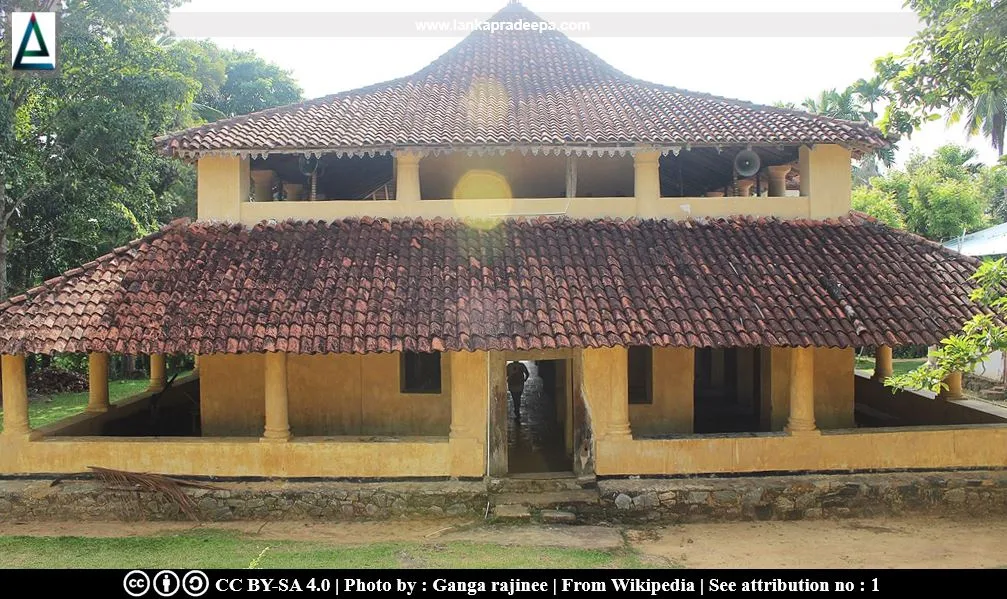
Dodantale Raja Maha Viharaya (also known as Sri Seneviratnarama Uposhitha Viharaya) is a Buddhist temple situated in Dodantale in Kegalle District, Sri Lanka.
History
The Vihara-geya (the image house) in Dodantale temple is believed to have been constructed by Chief Adigar Molligoda Rajakaruna Seneviratna Abhayakoon Herath Vahala Mudiyane (Abeyawardana, 2002; Bell, 1904; Wijayawardhana, 2010). The name of the temple "Senevirathna" indicates the link between the temple and Molligoda. The complete name of Molligoda is found in the "Molligoḍa Sannasa", a copper plate
inscription to gifting land to Molligoḍa Adikaram by King Sri Vikrama
Rajasinghe [(1798-1815 A.D.) Ranawella, 2015].
Molligoda is said to have designed the Vihara-geya to use as a royal palace after capturing the power of the Kandyan Kingdom (Abeyawardana, 2002; De Silva & Chandrasekara, 2009; Wijayawardhana, 2010). According to locals, the ground floor of this building was intended to use as a royal audience hall while the first floor as living quarters of royalty and the third for the Tooth Relic of the Buddha (Abeyawardana, 2002; Wijayawardhana, 2010). However, on second thoughts Molligoda converted it to a two-storied Buddhist shrine and therefore, the building was not completed as it had been designed in the original plan (Abeyawardana, 2002).
A palm-leaf manuscript (Tudapatha), which is preserved in the temple reveals that in the Saka year 1748 (1826 A.D.), the entire construction of the temple was completed and offered it with relics to the lineage of monks headed by Ven. Vathure Dhammarakkhita Thera (Wijayawardhana, 2010). It is possible that the Vihara-ge was completed
at that time by the son of the Molligoḍa Adikaram.
The Vihara-geya
Viharas are rarely of two stories (Coomaraswamy, 1908). Examples of this type of Viharas are found in a few localities such as Dodantale and Mahalloluwa (Wijayawardhana, 2010). The two-storied Viharaya of Dodantale temple is a roughly 50 ft. long and 40 ft. wide building (Wijayawardhana, 2010). Its ground floor is used for preaching and other purposes (Bell, 1904; Coomaraswamy, 1908). A wooden flight of steps leads on to the balcony that runs around the shrine room of the upper floor (Bell, 1904). The upper floor contains the shrine room (17 ft. 9 in. by 16 ft. 9 in.) and an inner verandah [(11 ft. 6 in. wide) Bell, 1904]. Half-round clay tiles have been used to cover the roof (De Silva & Chandrasekara, 2009).
Buddhist murals and sculptures belonging to the Kandyan tradition of the 18th century are found in the shrine (Coomaraswamy, 1908). Among the sculptures, there are three statues of Buddha; one in the seated position (5 ft. 8 in. by 3 ft. 10 in.) and the others in the standing position [(6 ft.) Abeyawardana, 2002; Bell, 1904; De Silva & Chandrasekara, 2009]. All the statues are carved out of timber (De Silva & Chandrasekara, 2009). The walls have been adorned with Buddhist themes such as Suvisi-Viwaranaya (Buddha to be receiving the blessing from 24 previous Buddhas) and the images of Arhats, Sariputta, Moggallana, and deities including Visnu, Saman etc. (Bell, 1904). Portraits of King Kirti Sri Rajasinghe (1747-1782 A.D.), Lewke Disawa and Molligoda Adikarama, and his son (Kuruve Disawa) are also found in the shrine (Abeyawardana, 2002; Bell, 1904; Wijayawardhana, 2010). Of them, Kirti Sri is represented with a valuable costume wearing the famous Kurulla-bendi-malaya (Coomaraswamy, 1908; Wijayawardhana, 2010). Coomaraswamy in his book "Mediaeval Sinhalese art (1908)" mentions a pendant named Kurulu Padakkama (the bird pendant) which is said to have been made for Mollogoḍa Adigar (Coomaraswamy, 1908). It has a Sinhalese inscription on
the reverse, the translation which reads as: “In the month of
Duruta in the year 1861 of Saka, the Padakkama made by Mangalagama
Muhandirama at Doḍantale” (Coomaraswamy 1908). It seems that Kirti Sri in this portrait wears a similar pendant.
Artifacts
A Kotalaya (a kettle) with stamped Bo-leaf ornament, a large wide-mouthed painted earthen vessel called Pathra, used to hold water or to receive offerings (such as rice) from worshipers, a plain lavatory stone, and the parts of two headless Buddha statues carved out of limestone have been unearthed from the Vihara premises (Coomaraswamy, 1907; Wijayawardhana, 2010). A crystal Buddha statue, that was recovered from the temple is presently on the display at the National Museum of Colombo. It has been dated by scholars to the 14th century A.D.
A protected site
The ancient Vihara-geya at Dodantale Sri Senevirathna Uposatha Raja Maha Vihara situated in the Divisional Secretary’s Division of Mawanella is an
archaeological protected monument, declared by a government gazette
notification published on 10 November 1978.
References
1)
Abeyawardana, H.A.P., 2002. Heritage of Sabaragamuwa: Major natural,
cultural and historic sites. Sabaragamuwa Development Bank and The
Central Bank of Sri Lanka. ISBN: 955-575-077-7. pp.72-73.
2) Bell, H.C.P., 1904. Report on the Kegalle District of the Province of
Sabaragamuwa. Archaeological Survey of Ceylon: XIX-1892. Government
Press, Sri Lanka. p.44.
3) Coomaraswamy, A.K., 1907. Sinhalese Earthenware. Spolia Zeylanica. (Vol: IV. Part: XIII). pp.7,18.
5) Coomaraswamy, A.K., 1908. Mediaeval Sinhalese art. pp.118,164,168,169,211.
6) De Silva, N.; Chandrasekara, D.P., 2009. Heritage Buildings of Sri
Lanka. Colombo: The National Trust Sri Lanka, ISBN: 978-955-0093-01-4.
p.20.
4) Ranawella, S., 2015. Archaeological Survey of Ceylon: Inscriptions of
Ceylon: Vol. IX. Department of Archaeology. ISBN: 978-955-9159-98-8.
pp.72-77.
7) The Gazette of the Democratic Socialist Republic of Sri Lanka, no: 10. 10 November 1978.
8) Wijayawardhana, K., 2010. Sri Lankawe Tampita Vihara (In Sinhala). Dayawansa Jayakody & Company. Colombo. ISBN: 978-955-551-752-2. pp. 153-164.
Location Map
This page was last updated on 1 July 2022


